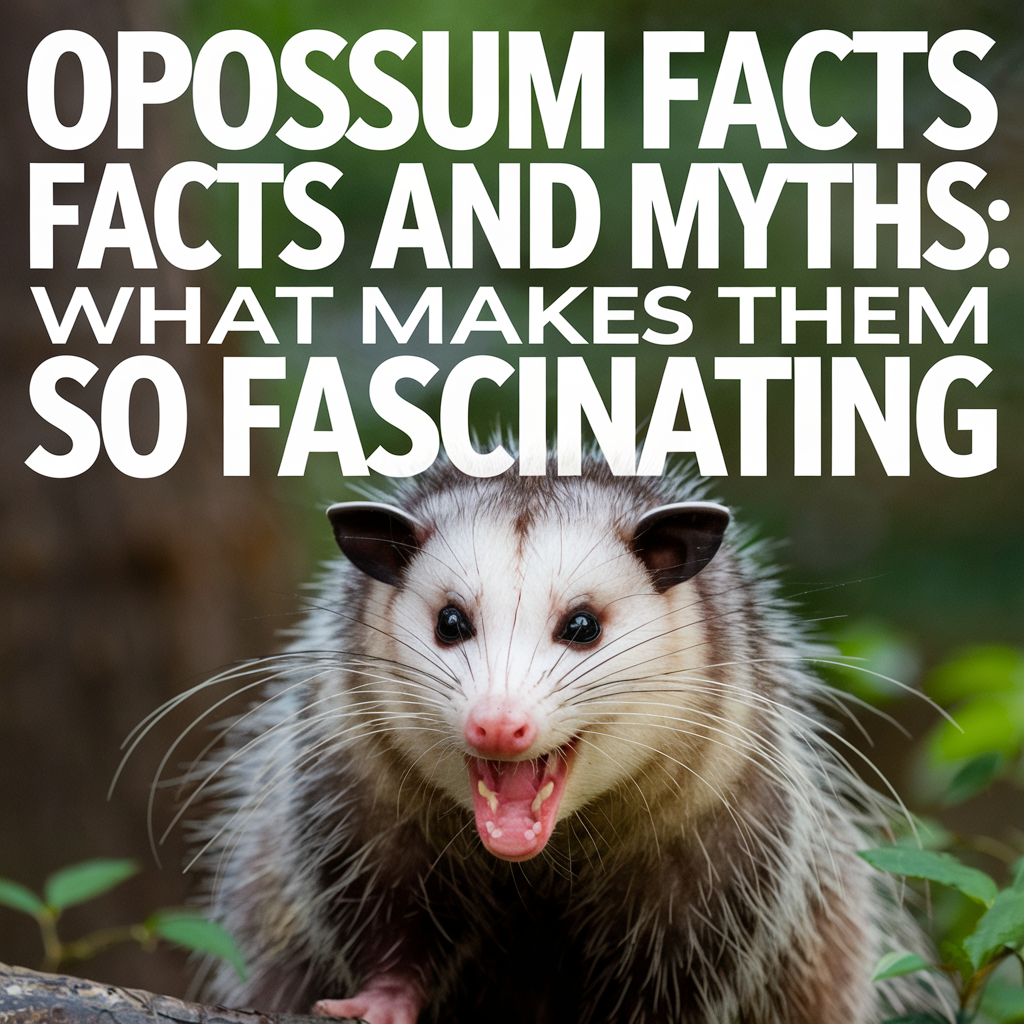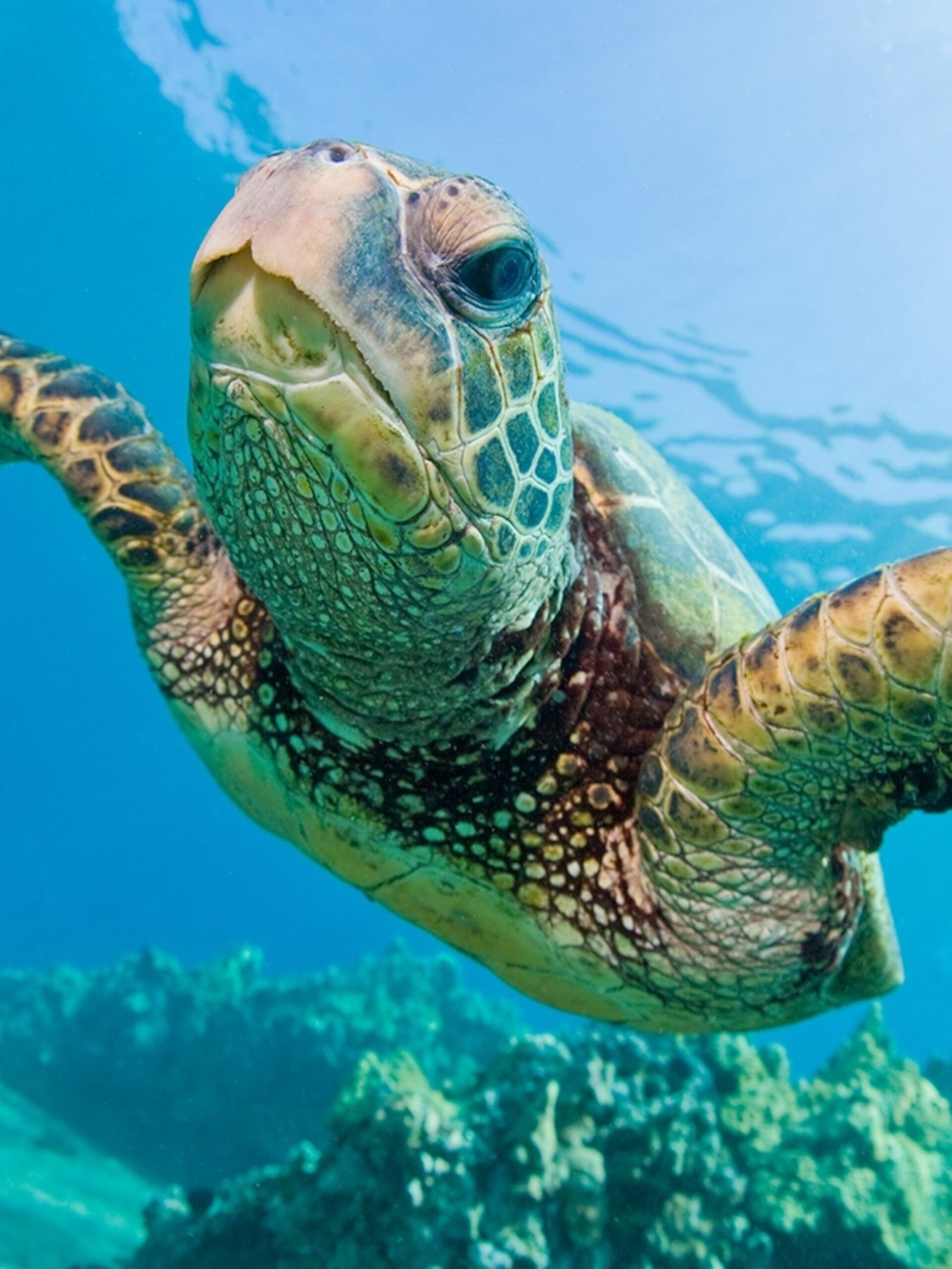
What is a Green Sea Turtle?
The green sea turtle (Chelonia mydas) is one of the largest and most widespread sea turtle species on Earth. It’s known for its smooth, heart-shaped shell and calm, gentle behavior that’s captured the hearts of beachgoers and divers all over the world.
Despite what the name might suggest, the green sea turtle doesn’t have a green shell. The name actually comes from the greenish-colored fat found inside its body — a result of its plant-heavy diet. These turtles are completely marine, except when females come ashore to lay eggs. Males never return to land once they hatch and head for the sea.
Unlike some more aggressive or meat-eating species, green turtles are mellow grazers. They spend their days slowly cruising through seagrass meadows and coral reefs, playing an important role in maintaining those ecosystems. Compared to other turtles of the sea like the leatherback or loggerhead, green sea turtles are especially known for their connection to tropical shorelines and long migrations.
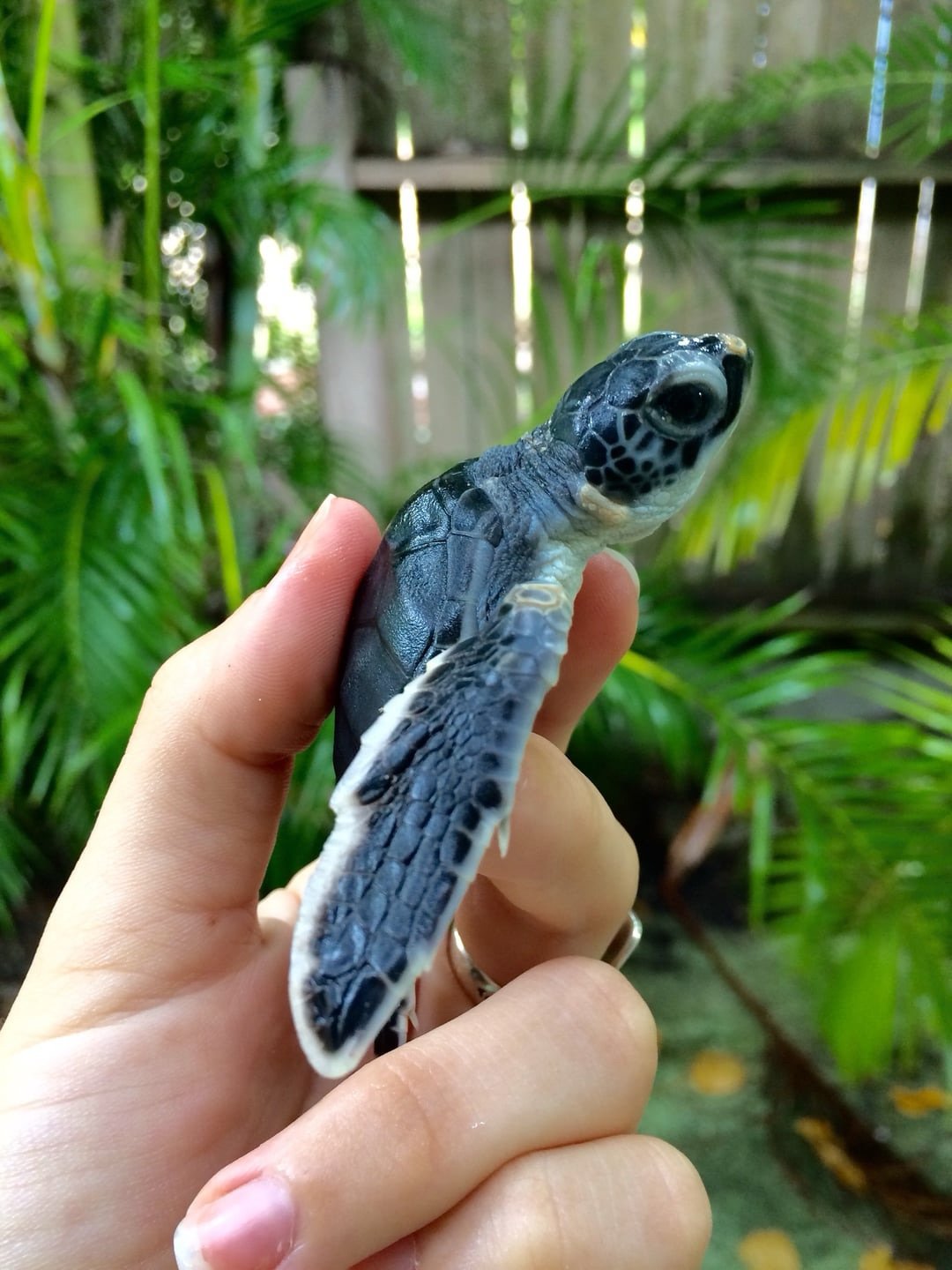
Where Are Green Sea Turtles Found?
Green sea turtles are world travelers. You can find them in warm coastal waters across every ocean — from the coasts of North America and Central America to the sandy beaches of Africa, Asia, and Australia. These turtles love tropical and subtropical regions, and they usually hang around coral reefs, seagrass beds, lagoons, and sandy beaches.
Some of the biggest populations nest in places like:
- Florida (USA)
- The Caribbean
- Mexico
- Costa Rica
- Indonesia
- Australia
- The Seychelles and East Africa
Since they are found on so many continents, they’re a perfect example of a truly global reptile. For readers exploring turtles by location, our guide to North American critters includes other turtle species that live right alongside the green sea turtle in U.S. waters.
These turtles are also migratory powerhouses. Some swim thousands of miles between their feeding areas and nesting beaches — sometimes across entire oceans!
How Did Green Sea Turtles Get Their Name?
It’s a common mistake to assume their name comes from their outer shell — which can range from dark brown to olive or even slightly golden hues depending on where they live. But the real reason they’re called green is much more interesting (and a little gross).
The fat layer inside their body has a distinctive greenish tint. Scientists believe this comes from their diet — mostly seagrass and algae. This plant-rich food source gives their fat a unique color not seen in meat-eating turtles.
It’s also worth noting that baby green turtles don’t look very green at all. As hatchlings, they tend to have a dark upper shell with light-colored undersides. Their appearance changes as they grow older and transition into their herbivorous adult phase.
So the next time you hear “green sea turtle,” remember — it’s not what’s on the outside that gave them their name. It’s what’s underneath the shell that tells the story.
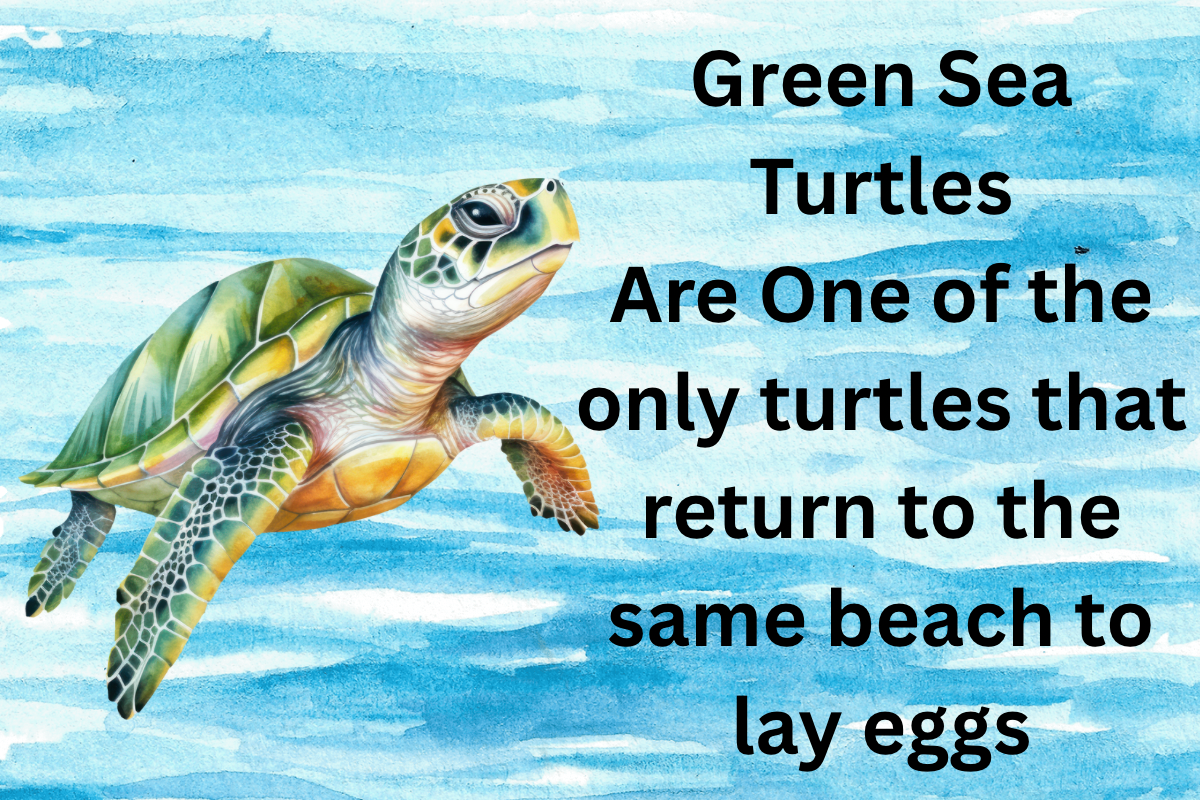
What Do Green Sea Turtles Eat?
Green sea turtles have a fascinating diet story. When they hatch, they’re omnivores — they eat tiny invertebrates like shrimp, jellyfish, and crustaceans. But as they mature, something shifts. Adults switch to a strict herbivore lifestyle, spending their days grazing on seagrasses and algae.
This grazing behavior is actually critical to the health of underwater ecosystems. Green turtles help maintain seagrass beds by trimming them, which encourages regrowth and keeps the marine environment balanced for other species too.
They’re like the underwater lawnmowers of the ocean — quietly doing maintenance that helps keep things clean and healthy for fish, coral, and even other turtles.
While browsing our Turtle section, you’ll notice not all turtles are this plant-focused. Species like the loggerhead and snapping turtle lean heavily into carnivorous diets. That’s what makes the green sea turtle so unique — especially for a reptile known to reach up to 400 pounds!
How Long Do Green Sea Turtles Live?
Green sea turtles are in it for the long haul. In the wild, they can live anywhere from 60 to 80 years, with some reports suggesting they may even reach 90+. That’s a pretty incredible lifespan for a cold-blooded creature floating through the ocean.
What’s fascinating is how long it takes them to reach adulthood. Green sea turtles don’t become sexually mature until they’re between 20 and 50 years old. That’s right — they spend decades growing before they even start the next generation. It’s part of the reason why conservation is so critical for this species. If too many juveniles die before reaching maturity, the population can’t sustain itself.
If you’re curious about other long-living turtle species, the leatherback sea turtle also holds an impressive lifespan and migration record.

Natural Predators of the Green Sea Turtle
As hatchlings, green sea turtles face an uphill battle. Crabs, birds, raccoons, and even fish are all waiting for that mad dash to the sea when the eggs hatch. It’s estimated that only 1 in 1,000 hatchlings will make it to adulthood.
But once they grow large, their list of natural predators gets very short. Adult green sea turtles are simply too big and strong for most marine hunters. Only large sharks — especially tiger sharks — are known to go after them. Occasionally, orcas might as well.
That said, humans have become the greatest threat of all. Through coastal development, poaching, boat strikes, and plastic pollution, we’ve made it much harder for these turtles to survive — even when they escape their natural predators.
Want to dive deeper into turtle conservation? Our upcoming guide on protecting endangered turtles will explore real-life solutions you can be part of.
Nesting Habits and Reproduction
When female green sea turtles are ready to lay eggs, they return to the same beach where they were born — sometimes decades later. This phenomenon, called natal homing, is one of the most awe-inspiring behaviors in the animal kingdom.
During nesting season, females crawl ashore at night, dig deep pits with their flippers, and lay up to 100 eggs per nest. They may repeat this process multiple times in a single season before heading back out to sea.
The eggs incubate for about two months, and when the time is right, hatchlings emerge in a flurry — racing toward the moonlit ocean.
Nesting beaches are often protected due to how vital they are for species survival. Florida, Hawaii, and parts of the Caribbean have become critical conservation hotspots. If you’re interested in wildlife of the Americas, check out our North American critters category for other fascinating animals found in these ecosystems.
How Green Sea Turtles Help Their Ecosystems
Green sea turtles play a huge ecological role in maintaining balance under the sea. Their constant grazing on seagrass prevents overgrowth, encourages healthy regrowth, and supports biodiversity in reef systems and lagoons.
Without them, seagrass beds can become overgrown and die off, affecting not just turtles but fish, crustaceans, and even humans who rely on healthy marine environments.
In a way, they’re like the silent stewards of the ocean floor — doing their part without fanfare, one bite of grass at a time.
This peaceful grazing behavior is a key trait that sets them apart from more aggressive turtle species like the snapping turtle.
How to Identify a Green Sea Turtle
Despite their name, green sea turtles aren’t actually green on the outside — they have a smooth, brownish or olive-colored shell with beautiful, mottled patterns. The “green” part refers to the greenish color of their body fat, which comes from their strictly herbivorous diet.
They have a more heart-shaped shell than some other sea turtles and a single pair of prefrontal scales between their eyes (most other sea turtles have two). Their heads are relatively small compared to their large, paddle-like flippers — perfectly designed for long-distance swimming.
If you’re ever snorkeling or diving and think you’ve spotted one, watch their movement. Green sea turtles are graceful gliders, often seen cruising calmly through coral reefs or resting near the seafloor.
Want to explore more turtle shell types? Don’t miss our post on turtle and tortoise shell facts — it breaks down how shells are much more than just a “suit of armor.”

Migration: How Far Do They Travel?
Green sea turtles are globe-trotters. They can migrate thousands of miles between feeding areas and nesting beaches. Some are known to travel from the coast of Brazil all the way to Ascension Island in the South Atlantic — a journey of over 1,000 miles across open ocean.
They navigate using Earth’s magnetic fields, a skill that’s still being studied. Scientists believe they imprint on the unique magnetic signature of their birthplace, helping guide them back decades later.
These incredible journeys show just how vital healthy oceans are. A turtle might pass through the waters of multiple countries just to complete one nesting cycle — making international cooperation key to protecting them.
For more amazing turtle species and their quirks, check out our turtle species article covering rare and unique varieties worldwide.
Why Are Green Sea Turtles Endangered?
Green sea turtles are listed as endangered under the Endangered Species Act in the U.S., and globally under the IUCN Red List. The main threats they face aren’t natural — they’re man-made.
Their population has declined due to:
- Egg harvesting and poaching
- Pollution and plastic ingestion
- Bycatch in fishing nets
- Boat strikes
- Habitat destruction from tourism and development
Even climate change poses a threat — warmer sand temperatures where eggs are laid can skew the gender balance of hatchlings, which are temperature-dependent during incubation.
Want to learn about more critters we need to protect? Visit our section on endangered animals to see how you can help.
Can You Swim With a Green Sea Turtle?
Yes — and it’s an unforgettable experience. But there’s a catch: you should never touch or chase them. In many places like Hawaii, the Caribbean, or the Great Barrier Reef, you might be lucky enough to snorkel alongside a green sea turtle in its natural habitat.
They’re often seen munching on seagrass or taking slow laps along the reef. Just remember, many regions have laws in place that protect sea turtles from human interference. Keep your distance, stay calm, and let them be.
These moments can be peaceful and powerful. Seeing such a massive, gentle creature up close leaves a lasting impression — and a stronger desire to keep their oceans clean and safe.
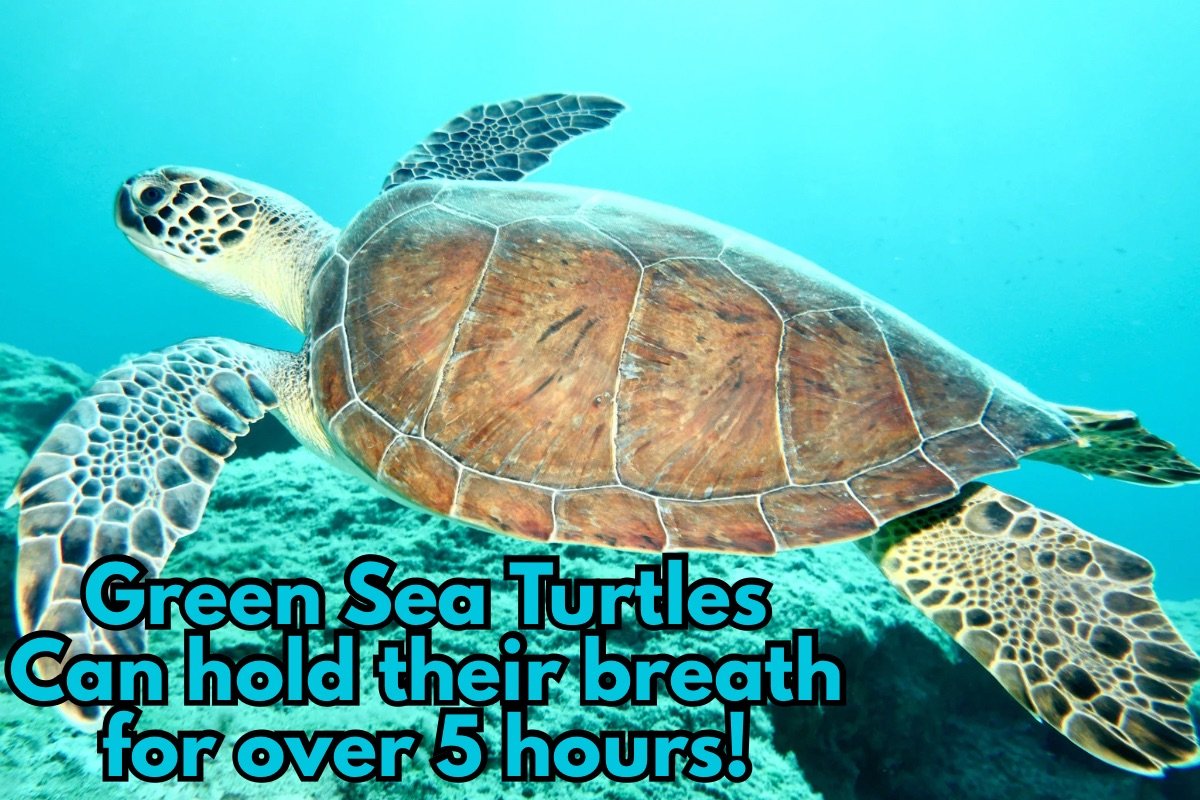
How Long Can a Green Sea Turtle Hold Its Breath?
Green sea turtles are air-breathing reptiles, but they’re masters of holding their breath. When actively swimming, they’ll typically surface every few minutes. But when resting or sleeping underwater, they can slow their heart rate and hold their breath for up to 5 hours!
They do this by drastically reducing their oxygen needs and blood flow. It’s a survival adaptation that helps them stay hidden from predators while napping on the seafloor or tucked under coral ledges.
It’s pretty wild when you realize these gentle giants, despite being ocean dwellers, still need to come up for air — which makes boat strikes one of the tragic threats they face. For more about unusual turtle traits, don’t miss our turtle shell facts article — it’s full of surprising info!
Cultural Significance of Green Sea Turtles
In many coastal cultures, green sea turtles are symbols of endurance, wisdom, and peace. In Hawaii, they’re called “honu,” and are seen as sacred guardians. In ancient Polynesian legends, they’re even believed to guide lost souls home.
Some Pacific Island nations also used turtle shells in traditional tools and art. While modern laws protect turtles from being harvested, their cultural value lives on in stories, tattoos, and conservation efforts.
Even today, seeing a turtle in the wild is often described as a spiritual experience — a moment of awe that connects people to the sea in a deep way.
Green Sea Turtles and Eco-Tourism
Eco-tourism centered around green sea turtles has become a powerful force for education and conservation. Destinations like Costa Rica, the Maldives, and Hawaii draw travelers eager to witness nesting, hatching, and reef gliding events.
Done responsibly, turtle-focused tourism can fund local conservation programs, promote awareness, and discourage illegal harvesting. Just make sure to choose guides and tours that follow strict wildlife ethics and avoid disrupting the turtles.
If you’re planning a trip, our article on ocean animals worth seeing gives a good preview of what other amazing creatures you might encounter.
What You Can Do to Help Green Sea Turtles
Helping green sea turtles doesn’t require living near the ocean. Here’s how anyone can make a difference:
- Reduce plastic use — turtles often mistake plastic bags for jellyfish
- Avoid products with turtle shells or eggs
- Support reef-safe sunscreens when swimming or snorkeling
- Donate to reputable sea turtle rescue groups
- Educate others with fun facts and real info
Every small action adds up. Even sharing articles like our turtle species guide can spread awareness to help protect these ancient mariners.
Final Thoughts For Now on the Green Sea Turtle
The green sea turtle isn’t just one of the most beautiful sea creatures alive — it’s a living symbol of resilience and balance. From their plant-based diets to their transoceanic migrations, these turtles are vital for healthy marine ecosystems.
Whether you’re spotting one in the wild or learning from afar, one thing is clear: the more we understand them, the more we appreciate how important it is to protect them. By keeping beaches clean, supporting conservation, and spreading awareness through great content, we help keep these graceful sea grazers gliding through the ocean for generations to come.
